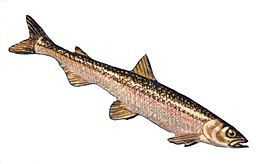Rainbow Smelt

Species Details
Osmerus Mordax
Osmeridae
Osmeriformes
River, Ponds, Lakes
0 - 1 lbs.
7" - 14"
Rainbow Smelt (Osmerus mordax) Fish Description
Rainbow Smelts are known to shine in different colors. Hence, it being called the Rainbow Smelt. They are covered in pale green, silver, and iridescent purple on their backs. Their sides are blue and pink. But their bellies are lightly colored but not completely white. They have a single dorsal fin and appear to have two anal fins. One anal fin is directly parallel to the dorsal fin and the other one is at the base of its deeply forked tailfin.
Rainbow Smelts kind of remind you of anchovies in terms of body structures. Not only are they small, but they’re also slender and cylindrical. Most of the time, people would rather use the Rainbow Smelt as bait due to its small size.
Diet and Size
Rainbow Smelts are aggressive fish. They will eat any fish they can find. However, in their younger years, Rainbow Smelts are known to eat zooplankton and young Ciscoes.
Rainbow Smelts are small. Like, they don’t even weigh past a pound! Adult Rainbow Smelts only reach up to 3 ounces. So, this kind of leaves you wondering how in the world they manage to eat other fish. As for their length, Rainbow Smelts grow at an average of 7 to 9 inches. That’s barely even one foot.
Interesting Facts
- Rainbow Smelts can quickly dominate water bodies.
- As fast swimmers, they ended up spreading their population everywhere.
- Despite being fast swimmers, they’re also pretty weak which is why they can’t go through water bodies that connect via water ladders.
- Rainbow Smelts are often used as bait to catch Walleyes, Salmons, Trouts, and Tunas.
- Rainbow Smelts can survive in freezing waters.
- Their bodies produce glycerol and antifreeze protein that allows them to move freely in lakes that have been frozen over.
- Rainbow Smelts are known to be anadromous. They migrate from saltwater to freshwater in order to lay eggs during the spring.
- During the wintertime, Rainbow Smelt becomes a popular gamefish.
- Not surprising considering, not all fishes can produce an anti-freeze protein.
- Though they are not considered an invasive species, Rainbow Smelts are still considered a non-native species which needs to be kept under control.
Fishing Techniques: How to Fish for a Rainbow Smelt
When catching a Rainbow Smelt, anglers would recommend using marine worms or some fish that they like eating. One of those fishes that the Rainbow Smelt like eating is juvenile ciscoes. Or even cut up ciscoes might serve as a good bait for catching and luring a Rainbow Smelt. Although, artificial lures work well with them too.
Marine worms such as blood worms or sandworms can definitely attract a Rainbow Smelt. However, anglers usually dunk them in Mercurochrome. An iodine solution that makes the marine worm more resistant against the current and more similar in smell to the marine worms that Rainbow Smelts are commonly accustomed to eating.
As for the fish you can use, young Rainbow Smelts like juvenile Ciscoes. Older ones prefer herring, anchovy, silversides, and other smaller fishes. However, some anglers also choose to use the Smelt itself as bait. The success rate however is much better if you’re using anchovies as they have a strong smell.
Artificial baits – specifically ones painted white or red – are the best to attract the Rainbow Smelt.
Habitat and Distribution
Rainbow Smelts have spread almost everywhere in North America. They’re usually found in watersheds. However, they’ve made their way through the Atlantic drainages and also into the Great Lakes. Some have even found Rainbow Smelts staying in waters near Vancouver Island.
However, Rainbow Smelts still have a particular preference for rivers, ponds, and lakes. The waters need to be not any deeper than 20 ft and not a mile farther from shore. Most of the summers, they would spend their days near the coast.







